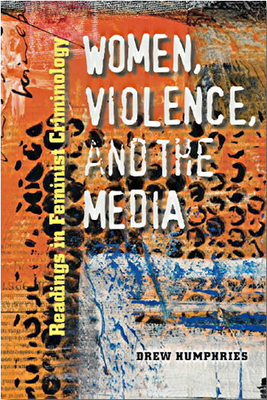Women, Violence, and the Media Readings in Feminist Criminology

At times, much like a good teacher, this book had my full attention. At other times, I nodded off. When I was three-quarters the way through, I began to wonder why it sounded like one of my old college text books. When I finished the 279 pages and went back to the preface, which I had long forgotten, I learned why: it was written for college students. That explained it. Had I not had to review it, I might have put it back on the shelf with those other books from a decade or so ago.
It’s not to say Women, Violence, and the Media: Readings in Feminist Criminology was uninteresting. It seeks to describe how women and violence are framed in fictional and non-fictional accounts, which interests me a great deal. The editor, Drew Humphries, professor in the department of sociology, anthropology and criminal justice at Rutgers University, pretty much achieves her aims. It’s just that like most people, I’d prefer to read about TV shows I watch. So, for example, I would enjoy reading an analysis of Dateline or even America’s Most Wanted. Do they serve to enlighten or to frighten? Do they show more cases of male violence than female violence, or is it in proportion to actual crime rates? This would interest me. Instead, there are chapters about Law and Order and Prime Suspect, shows that are popular, but that I don’t personally watch.
Even though I don’t have cable, I did find it interesting that Lifetime does well at depicting crime. It can broaden our understanding of crime because it shows subsequent victimization (like when a rape victim goes to a hospital and faces judgemental behavior by medical staff), which other programs often fail to include. They also have a balanced creative team. Oxygen and Women’s Entertainment actually have more males than females directing, producing and writing. Sounds like false advertising to me!
I would also have loved to read more about victim blaming, but it was only touched upon. I am always shocked and disheartened by news accounts on interpersonal violence and the comments that are sure to follow them. The editor says that victim blaming gives men “an edge in the court of public opinion and frequently in criminal court as well.” I never thought of it that way, but it makes sense. In chapter one (“Words That Wound”), the writers say that victims get more support when their behavior follows gender norms (example: wives like Lacy Peterson), and that made sense, too.
The chapter that compared mass rapes in Yugoslavia to those in Rwanda was interesting. The authors quote a researcher who says women are viewed as “victimized women rather than as persecuted citizens.” They analyzed how the media framed the situations in both countries, noted the different terms and emotionally-charged words that were used and how human rights organizations even responded differently to both countries.
Another chapter focuses on mass murder in domestic context. Working in the field of domestic violence myself, the information on this issue confirmed what I had already knew about it (and then wondered, do reporters ever read books like these?), particularly in regard to the media reporting on “nice guys” that inexplicably “snap.”
Once I got through the book, I enjoyed going back over the highlighted parts, which succinctly provided me with information. Since the book has a lot of material to wade through, I would encourage reading this book for a college course, as intended. All in all, I give it a B-.
"All in all, I give it a B-?" Have we sunk to the level of American Bandstand in our review writing and in our editing thereof? This review was forwarded to my office, and I was hoping to be enlightened about the possibility that this book could enlighten some of my male (and female) colleagues. Alas and alack.
Why would anyone complain about the length of the book she is reviewing or begin by confession of narcolepsy? Words such as "preface," "sociology" and "department" ought to have been capitalized, since they are proper nouns in this context.
You say "editor," but you don't describe then what kind of an edited collection this is? The sub-title suggests that this is a "reader," so perhaps you could have suggested the length and breadth of the field(s) from which the individual pieces were culled. I wonder whether it contains any pieces I read in Police Academy or in some college courses later on.
You say "the authors quote a researcher" but not which authors or which researcher or from which background. Tell us about the field of feminist criminology, since that's the feminist standpoint from which the book comes, right? I'm a cop, and a woman, and a feminist, but some of my colleagues (men and women) are just cops, if you get my point.
You don't mention who it is that views the Yugoslav or Rwandan women as "victimized women." Was it the authors, the editor, other Yugoslavs, media figures? I'm not sure how your lack of cable access relates to Lifetime doing "well at depicting crime," or why you dink the editor/authors for lack of inclusion of t.v. shows you like to watch, but the further implication that because Oxygen and Women's Entertainment have "more males than females directing, producing and writing" sounded like "false advertising" to you suggests again that readers of your review, perhaps even yourself, might enjoy learning about feminist criminology.
I work in domestic violence, too, and I happen to be a police detective in a Homicide division. Lifetime and Oxygen-type depictions of crimes against women (not "domestic violence," as you say) are the problem, not the solution.